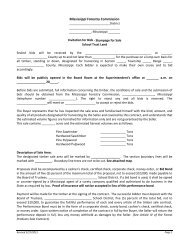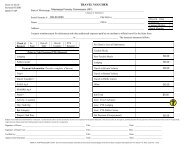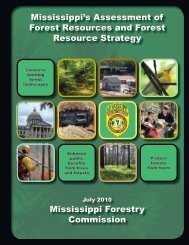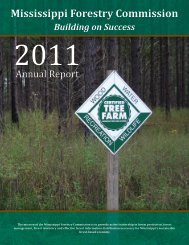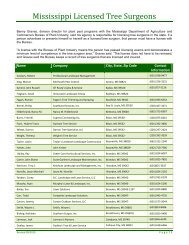Selling Your Timber
Timber Sale Brochure - Mississippi Forestry Commission - ms.gov
Timber Sale Brochure - Mississippi Forestry Commission - ms.gov
- No tags were found...
You also want an ePaper? Increase the reach of your titles
YUMPU automatically turns print PDFs into web optimized ePapers that Google loves.
Properly managed<br />
forests yield more timber,<br />
have a higher net<br />
present value, suffer<br />
fewer environmental<br />
impacts, and enhance<br />
wildlife habitat more than<br />
non-managed forests.<br />
You should always<br />
consult with a registered<br />
forester and attorney<br />
when drafting a timber<br />
sale contract.<br />
Whether you’re dealing<br />
directly or indirectly with<br />
a timber buyer, wood<br />
supplier, logger, registered<br />
forester or consultant, you<br />
should always request<br />
references, experience,<br />
applicable licenses, and<br />
certifications.<br />
5.<br />
• Negotiated sales involve face-to-face bargaining<br />
between you and the buyer.<br />
• Sealed bid sales require that prospective buyers<br />
submit confidential offers in writing for your timber.<br />
Generally, the sealed bid method returns the highest<br />
dollar value to you, the landowner, especially if you<br />
are unfamiliar with local markets. The negotiated sale<br />
is more prevalent for specialty products such as highvalue<br />
hardwoods, where there are normally very few<br />
bidders. Whichever sale method is selected, you should<br />
require the logger to be Professional Logging Manager<br />
(PLM) certified.<br />
A trained professional logger can ensure trees are<br />
effectively harvested and merchandised in a manner<br />
that fully utilizes Best Management Practices (BMPs).<br />
This is particularly important as more emphasis is<br />
being placed on protecting and enhancing water quality.<br />
It’s a good idea to take time to know the prospective<br />
logger by asking for references, business experience,<br />
and whether they have completed PLM training. You<br />
or your agent can verify they’ve attended Mississippi’s<br />
PLM course by going to the Professional Logging<br />
Manager’s website at www.loggered.msstate.edu/<br />
(If you choose to sell your timber through the bid process,<br />
you may limit your ability to specify a particular logger.)<br />
Have a Contract<br />
A written contract is essential and will reduce<br />
surprises to both you and the buyer and/or logger.<br />
Preparing a contract encourages forethought and planning,<br />
which will minimize difficulties and ensure that the<br />
transaction meets your expectations. A contract is not a<br />
substitute for good faith and fair dealing between parties,<br />
it is a framework in which good faith and fair dealing<br />
can operate in an orderly and effective manner.<br />
The following items should be included in a timber<br />
sale contract:<br />
<strong>Timber</strong> Description<br />
• An Accurate Legal Description:<br />
In the contract, state the exact location and legal<br />
description of the timber sale area.<br />
• Marking Corners and Boundaries:<br />
The contract should state at whose expense<br />
marking will be done and how the boundaries and<br />
Preparing a contract<br />
encourages forethought<br />
and planning, which will<br />
minimize difficulties and<br />
ensure that the transaction<br />
meets your expectations.<br />
corners will be marked.<br />
• <strong>Selling</strong> <strong>Timber</strong> on a Per-Unit Basis:<br />
If you choose to sell timber by the unit, specify the<br />
units of measurement to be used, who is to do<br />
the measuring, and where. Measurements may<br />
be made by one of several different methods: log<br />
scales, weight, cords, or some combination of<br />
these. A per-unit sale should specify that all timber<br />
harvested is to be measured and paid for according<br />
to its most valuable product use.<br />
• The Type of Harvest:<br />
Specify the type of harvest you desire and if the<br />
timber is marked, how it’s marked. For example, if<br />
you are making a seed tree cut, you may specify<br />
that all trees banded with blue paint 4-1/2 feet<br />
above ground (Diameter at Breast Height, DBH)<br />
are seed trees and will not be cut or damaged. If<br />
you are thinning or using a select cut, you may<br />
want to designate the trees to be cut with one<br />
paint spot above DBH and another below the<br />
stump height. If you are doing an operator-select<br />
harvest, specify selection guidelines in the contract.<br />
Payment, Damage Clauses, and Penalties<br />
The following are provisions to consider including in<br />
a timber sale contract. Be aware that some restrictions<br />
placed on harvesting may lower the price someone is<br />
willing to pay for your timber, so be reasonable in your<br />
expectations.<br />
• <strong>Selling</strong> <strong>Timber</strong> on a Lump-Sum Basis:<br />
If you are selling your timber on a lump-sum basis,<br />
specify that you desire payment in full at the time<br />
of contract execution; or if you are deferring payment,<br />
the exact date(s) you expect payment.<br />
(A lump-sum sale is the outright sale of standing<br />
timber for a fixed dollar amount agreed upon in<br />
advance. The sale price is not a function of the<br />
volume cut.)<br />
• <strong>Selling</strong> <strong>Timber</strong> on a Per-Unit Basis (price):<br />
If you are selling on a per-unit basis, specify the<br />
payment per unit for each species and product,<br />
as well as timing of payments. Additionally, agree<br />
on the method and place of scaling and measurement.<br />
Also, you should require in the contract that<br />
the buyer provide you with a complete accounting<br />
of all species and products by delivery point that




